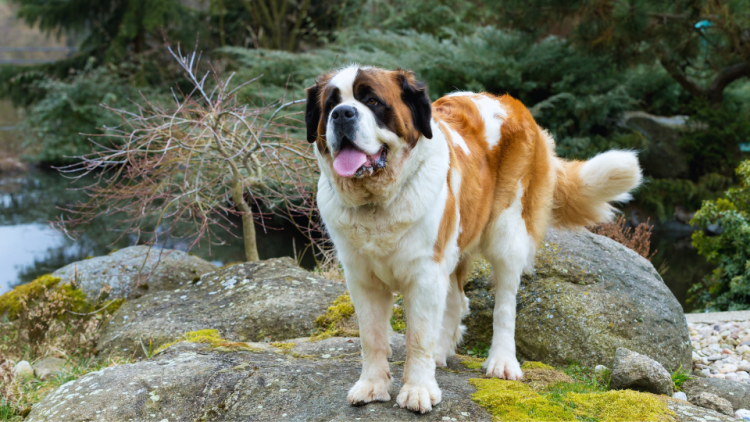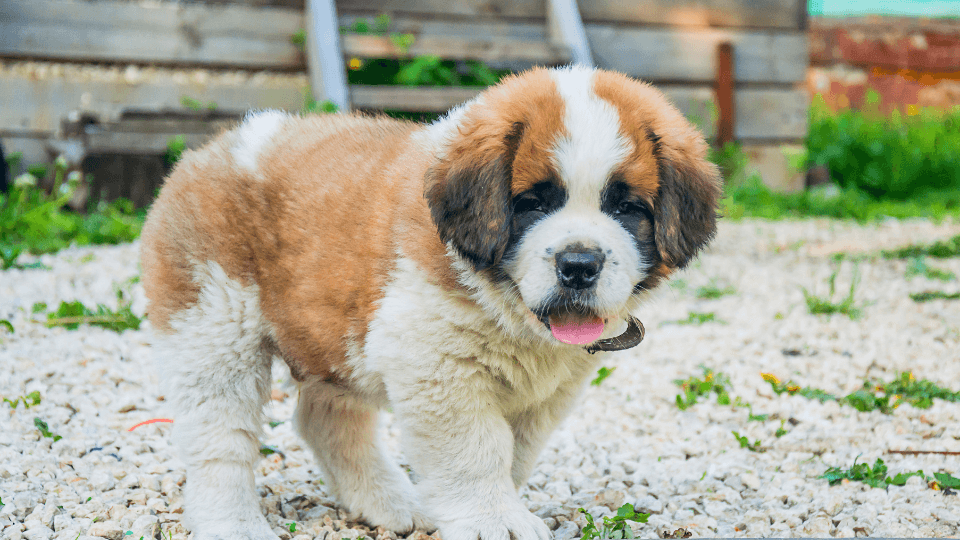St. Bernards are legendary working dogs known for finding paths and rescuing people in the Alps using a highly developed sense of smell. Their large size, powerful bodies, and friendly faces make welcome sights for those lost in the snow. These gentle giants are estimated to have saved over 2,500 human lives since monks began documenting their rescue work over three centuries ago1.
If you're a proud pet parent to this patient, watchful breed, our St. Bernard growth chart can help you track approximately how big your puppy will get throughout stages of its development. Or, if you're thinking about adding a new, furry family member to your home, you might be wondering how much does a St. Bernard weigh, considering their massive size.
In any case, here’s everything you need to know about St. Bernard growth and development:
- St. Bernard Growth & Weight Chart
- When do St. Bernards stop growing?
- How much should an 8-month-old St. Bernard weigh?
- How much bigger will my St. Bernard get?
- How much does a St. Bernard weigh on average?
- How do I make sure my St. Bernard is healthy?
- Key Takeaways
Pro Tip: Want to be reimbursed for up to 90% of your dog’s veterinary bills whenever they are sick or injured? Compare St. Bernard health insurance options today.
St. Bernard Growth & Weight Chart
As a giant dog breed, St. Bernards undergo rapid growth to achieve their final size. Within the first few months of a St. Bernard puppy’s life, they will have already grown more than many dogs do throughout their entire lifetime.
If your pup is slightly ahead of or behind the numbers on the St. Bernard weight chart, don’t worry. The above numbers are estimates, and every puppy grows at its own rate.
If you notice your St. Bernard puppy is significantly ahead of or behind these ranges, reach out to your veterinarian to make sure your puppy is growly appropriately. Your pup’s health and happiness is the most important thing!
St. Bernard Growth and Weight Chart
| Age | Male Weight | Weight |
|---|---|---|
| 1 month old | 10 - 25 lbs | 10 - 20 lbs |
| 2 months old | 25 - 40 lbs | 15 - 35 lbs |
| 3 months old | 40 - 55 lbs | 35 - 50 lbs |
| 4 months old | 50 - 65 lbs | 45 - 65 lbs |
| 5 months old | 65 - 80 lbs | 55 - 80 lbs |
| 6 months old | 80 - 100 lbs | 65 - 90 lbs |
| 7 months old | 90 - 110 lbs | 75 - 100 lbs |
| 8 months old | 100 - 120 lbs | 85 - 110 lbs |
| 9 months old | 105 - 125 lbs | 90 - 115 lbs |
| 10 months old | 115 - 135 lbs | 90 - 115 lbs |
| 11 months old | 125 - 150 lbs | 100 - 120 lbs |
| 12 months old | 130 - 165 lbs | 110 - 130 lbs |
| 2 years old | 140 - 180 lbs | 120 - 140 lbs |
When do St. Bernards stop growing?
You can expect your St. Bernard to approach their adult weight around a year old, but they will need another 6-12 months to finish filling out their chest. By two years old, most St. Bernards stop growing altogether.
St. Bernard puppy development is much slower than most other dog breeds. By comparison, small dogs stop growing around 9-12 months, while medium to large canines taper off near the 12-18 month mark. However, breeds that are classified giant in size - like the Great Dane, Cane Corso, and Bernese Mountain Dog - grow for as long as 24 months before reaching full maturity.
How much should an 8-month-old St. Bernard weigh?
An average St. Bernard male should weigh between 100-120 pounds at 8-months-old, whereas females of the same age should weigh 85-110 pounds. Both male and female puppies will be about 75% of their mature height, putting them at about 21-23 inches tall and 19-21 inches tall at the shoulders, respectively.

Pro Tip: If you’re a new owner of a St. Bernard puppy, don’t miss our ultimate guide for pet parents. It’s packed with 39 dog care tips on bonding with your pet, puppy-proofing your home, obedience training, microchips, and more!
How much bigger will my St. Bernard get?
It might feel like your St. Bernard puppy keeps growing bigger and bigger - and that’s probably because they are! If they haven’t turned two yet, you can expect more growth to come. It may be less noticeable, however, because the St. Bernard growth spurt slows down significantly after their first birthday and begins to plateau until growth stops around age two.
Depending on the age of your puppy, they might not get much bigger in terms of height, but pups under 18 months likely have a lot more space to fill out in the chest and legs areas. If you’re not sure of your puppy’s exact age and can’t reference our St. Bernard growth chart, another way to predict how much bigger they might get is by looking at their puppy paws. If they look oversized compared to the rest of the body, they’re likely still growing.
Breeders are another great source of information on a puppy’s predicted size, as they will know the size of the parents and the previous litters. They should be able to supply you with a more unique estimate of how big your St. Bernard will get.
How much does a St. Bernard weigh on average?
According to the American Kennel Club Official St. Bernard Standards2, a male St. Bernard should weigh between 140-180 pounds and stand 28-30 inches tall at the shoulders. Comparatively, a female St. Bernard should weigh around 120-140 pounds with 26-28 inches of height at the shoulders.
Both female and male St. Bernards should have a strong, muscular figure with a wide skull and short muzzle. Though they can look stern, St. Bernards are not ill-natured and tend to be very friendly with an intelligent expression.

How do I make sure my St. Bernard is healthy?
As giant, purebred dogs, St. Bernards are more susceptible to some genetic health issues. In particular, the St. Bernard breed is at a heightened risk of bloat, hearing loss, eye cataracts, bone cancers, and hip dysplasia.
Hip dysplasia occurs when the hip joints form improperly either before birth or as a puppy, and it can lead to hind-limb pain, limited mobility, and even lameness. Large and giant dog breeds are at a heightened risk of hip dysplasia due to their extremely fast growth rates as puppies, which can place excessive stress on their joints. According to the Veterinary Centers of America (VCA)3, it’s recommended that St. Bernards are specifically fed a large-breed puppy food that is formulated by veterinarians who specialize in nutrition to support their accelerated growth during this time.
St. Bernard Veterinary Costs
Dog food for large breeds does not directly affect their overall size at maturity, but rather slows their growth rate so that their joints are put under less stress, giving them more time to grow into their size while reducing the risk or severity of hip dysplasia later on. Hip dysplasia is usually treated with surgery, which can easily cost between $1,200 to $7,000 per affected hip, depending on the severity. If your St. Bernard needs both hips replaced, it can cost up to $14,000 for treatment.
If these figures scare you, you’re not alone. Out of 20,000 pet parents surveyed, only 19.44% said they would be able to cover a $5,000 veterinary expense out of pocket, leaving many in a precarious position should their four-legged friend develop an unfortunate condition. This is where pet insurance comes in.
Pet insurance provides you with a financial safety net should your dog require expensive veterinary treatment. Like humans, dogs are living longer, which means there is a greater need for supportive care to help them happy and healthy lives. Unfortunately, vet costs can become quite expensive, leaving many of us in a pinch. The decisions you make about your pet’s healthcare should never be restricted by finances. Pet insurance alleviates monetary stress by reimbursing you up to 90% for out-of-pocket veterinary expenses, so you can provide your St. Bernard with access to the care they deserve.
Not only does pet insurance protect you if your pup is injured or ill, but wellness plans can also help with the everyday costs of preventative care, such as routine veterinary exams, x-rays, dental cleanings, and more.
Key Takeaways
- St. Bernards grow until the around the age of two, but accumulate most of that growth before they turn one.
- An average St. Bernard weighs between 140-180 pounds (male) and 120-140 pounds (female).
- Our St. Bernard weight chart can help you monitor your puppies growth and development to ensure they're healthy and on-track with official standards.
- The breed requires specific food and is known for common health problems, but pet insurance can provide financial assistance for veterinary care.
References:
- Brittanica. "St. Bernard https://www.britannica.com/animal/Saint-Bernard-breed-of-dog/" Accessed Apr. 26, 2021.
- AKC. "St. Bernard Standards https://images.akc.org/pdf/breeds/standards/SaintBernard.pdf" Accessed Apr. 26, 2021.
- VCA. "St. Bernard https://vcahospitals.com/know-your-pet/dog-breeds/saint-bernard/" Accessed Apr. 26, 2021.
